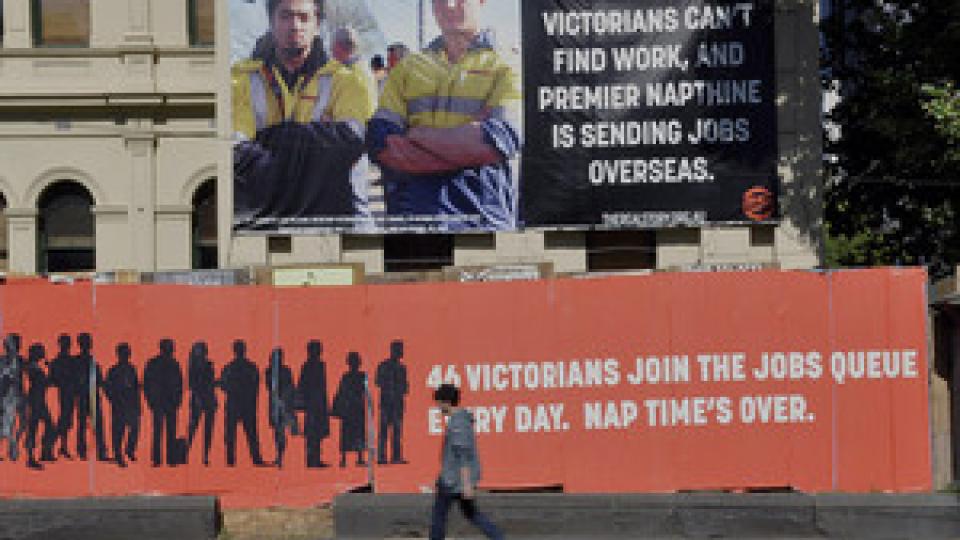Why Victoria dumped the Coalition
The Denis Napthine government, elected by a slim majority in 2010, has fallen in Victoria. This is the first time a Victorian government has lasted only one term since 1955, when the Cain Labor government fell in the midst of the great Labor split.
The Napthine government had lost support due to brutal public sector cuts, vindictive attacks on nurses, paramedics and teachers, the unpopular East West Link project, and corruption scandals that led to the removal of Ted Baillieu as premier last year and the sacking of several Liberal candidates before the poll.
A large number of postal and early votes (about one third of the total) and several close seats meant the final results for the lower house were still not known. But it appeared Labor would win 48 of 88 seats, with a primary vote of 38.3%, 2% up from 2010. The Liberal and National parties between them received 43% of the lower house primary vote and it appears, 39 seats, 1.8% down on 2010.
The Nationals in particular seemed set for crisis, losing several seats to Labor in regional cities, where working people are disgusted at the savage cuts to the TAFE system. They also lost the seat of Shepparton for the first time since it was created 47 years ago, to independent Suzanna Sheed, and looked set to lose official party status in the parliament if they gained less than 11 seats in the lower and upper houses, as appeared likely.
The Greens looked set to break into the lower house with Ellen Sandell’s victory in the seat of Melbourne. However, despite this, and impressive votes in other inner city seats — such as 38% in Brunswick (8% up on 2010) and 33% in Richmond (3.3% up on 2010), their state-wide lower house vote was 0.6% down on the last poll, at 10.6%.
Due to complicated preference flows, the upper house results would not be clear for some time. However, it was near certain that Labor will not have a majority in that chamber, nor would they be able to form a majority with the Greens. Part of the reason for the latter is that Labor made preference deals with reactionary outfits such as the Democratic Labor Party, the Shooters and Fishers Party and Family First.
The far right, despite tiny primary votes, were likely to gain several upper house seats on the back of Labor preferences ahead of the Greens (the Greens looked like retaining their three seats in the 40-seat upper house).
Labor had made a tack to the left, with slogans of “with the Liberals, you’re on your own”, and “Labor: Putting people first”, presenting at least a rhetorical alternative to the rampant neoliberalism of the Coalition. Labor also promised to increase spending on health, education and public transport although the amounts pledged do not replace the recent cuts. In the case of TAFE, the ALP promised to replace only $320 million out of $1.2 billion taken from the gutted public vocational education system.
Labor probably also gained, particularly in the inner city, with a last-minute promise to stop the East West Link project, counterposing the removal of level crossings and some improvements to public transport. This move undercut some support for the Greens. The Greens outside the inner city probably also suffered from their strategy of concentrating resources on their areas of core support where they thought they had a strong chance of winning seats.
The East West Link was a big focus of the election campaign because of its vast (at least $18 billion) expense, the secret nature of its business case, the destruction of houses and parks involved, and the fact that if it were built it would mean no serious investment in expanding public transport for 30 years.
However, clever and splashy advertising late in the campaign created the false impression that the East West Link was part of a project to improve public transport. Opinion polls suggested some people were misled into thinking that they could have both public transport and the East West Link.
Labor figures claim they gained from a much more grassroots style of campaigning, mobilising thousands of members and supporters — including union members under particular attack by the Coalition, such as ambulance drivers, fire fighters and nurses — for targeted doorknocking and ringing.
The Victorian Trades Hall Council initiated a We Are Union campaign early this year that mobilised hundreds of union members and supporters to doorknock selected marginal seats to get rid of the Napthine government. The VTHC claimed this would build activism for future struggles but they also demobilised any street campaigning against the federal government’s savage budget or other issues from July.
The Greens, the unions and the Labor party have all sent people over to the US to work on US Democratic Party campaigns including the Obama campaigns. These “grassroots” campaigns have been based on the fact that most people are cynical about election campaigns and political parties.
The environment and climate change were absent from the election campaigns of the major parties. The Labor party candidates in Moreland, Pascoe Vale and Northcote all refused to attend candidates meetings on climate change. The Greens and socialist candidates tied opposition to the East West Link to the urgent need for more public transport and for a rapid shift to renewable energy.
